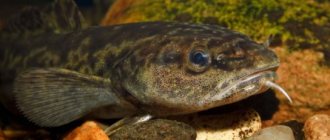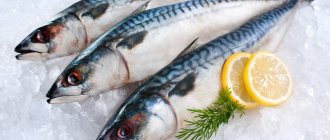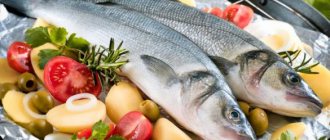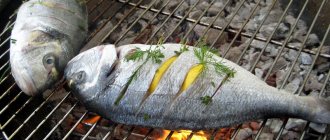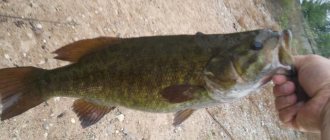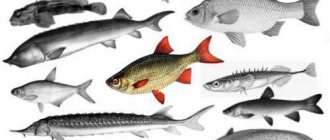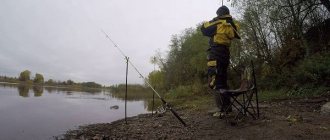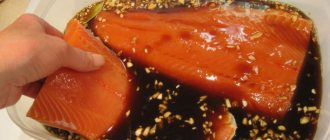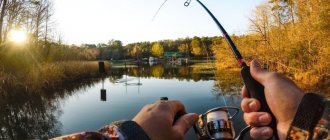Pollock is a cold-loving fish of the cod family that lives in bottom-pelagic layers of water.
Its greatest distribution is recorded in the North Pacific region. Which fish tastes better?
- Cod 49%, 1220 votes
1220 votes 49%1220 votes - 49% of all votes
- Pollock 27%, 672 votes
672 votes 27%
672 votes - 27% of all votes
- Heck 23%, 576 votes
576 votes 23%
576 votes - 23% of all votes
Total votes: 2468
04.12.2019
×
You or from your IP have already voted.
Characteristics of pollock
This fish chooses cold water to live (up to a maximum of 10 degrees) and during the daytime goes to a depth of up to 300 meters. These two points are partly related. At night, the fish prefers to stay in the middle or upper layers of water. Because of this, the pollock fish is characterized as pelagic (that is, it lives in the corresponding pelagic water columns). Since it is not bottom (deep-sea), this determines the ease of catching and what the fish looks like.
Pollock can descend to a depth of five thousand meters or more, traveling to spawning grounds. The life cycle is long and is about 15 years. Spawning forces pollock to move into shallow water, so during this time period large concentrations of spawning fish can be observed directly off the coast (50 meters from the coastline).
How not to harm your health
Pollock has been used in cooking since ancient times. You can prepare delicious dishes from this fish quickly and easily: boil, bake, stew or simply fry. Pollock is used to make flour, minced meat, canned food, caviar, and the fish is dried, salted and smoked.
Advice: Those wishing to lose excess weight should consume pollock only in stewed or boiled form. Fried fish, richly seasoned with a variety of sauces, has a high calorie content.
People suffering from gastritis, stomach ulcers, duodenal pathology or kidney disease should eat exclusively boiled and stewed fish.
Pollock should appear in a child's diet when the baby reaches two years of age. This is due to the high concentration of elements contained in fish. Benefits for children: strengthens hair and teeth, compensates for errors in the diet.
The best side dish for pollock is brown rice and vegetables.
If you pour lemon juice or soy sauce over cooked fish and season with herbs, it will not seem bland.

Appearance
The length of the body reaches 90 cm, and the weight increases throughout life to 5 kg. It has an elongated body shape, which is typical for most fish species. The narrowing is fixed in the direction from head to tail. The body covering consists of silvery scales.
Distinctive features of this type of fish:
- there are 3 fins on the back: the first is closer to the head of medium size, then the most elevated and large;
- specificity of the lower fins: the abdominal ones are located in front of the pectoral ones;
- a small antennae grows under the lower jaw;
- darkened back and spots all over the body, as well as a marsh green tint on the sides;
- disproportionately large head and eyes, which can be seen in numerous photographs;
- the lower jaw protrudes forward in relation to the upper.
Sexual maturation of individuals reaches its peak after 3-4 years of life. During this period, maximum body weight is gained. In the standard, it can reflect different indicators depending on the habitat. More specifically, vary in the following range: 2.5-5 kilograms.
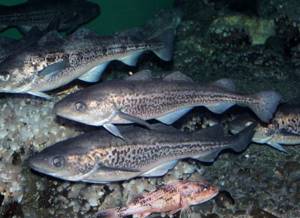
Baked pollock fillet with lemon and herbs
Baked pollock fillet with lemon and herbs. Photo: Shutterstock.com
- 2 strips of pollock fillet
- 1/2 bunch of parsley
- 2 tbsp. l. lemon juice
- zest of 1/2 lemon
- vegetable oil for frying
- salt and freshly ground black pepper
Step 1 . Finely chop the parsley, add zest and lemon juice.
Step 2 . Salt and pepper the fish.
Step 3 . Grease the mold with vegetable oil, put the fish in it, then add herbs and lemon to the fillet, sprinkle with vegetable oil.
Step 4 . Bake for 20 minutes in an oven preheated to 180 degrees.
Diet
In terms of what pollock eats, it can be compared with mackerel, cod, tuna and horse mackerel (“related” fish species). He finds food for himself at several levels of the food chain, not far from each other. Changes in diet are especially evident as individuals grow older.
What to eat at the beginning of life:
- plankton (small crustaceans);
- amphipods;
- krill;
- nematodes.
Then, as they grow, larger prey is added to the diet, which the individuals hunt on their own. Most often these are squid and small fish.
In what cases is it recommended to use
Consumption is recommended for people with heart disease, thyroid dysfunction, and diabetes. The presence of pollock in the diet has a beneficial effect on vision, the genitourinary system and the digestive tract. Fish serves as an assistant in the treatment of skin ailments, viral and fungal infections.
Advice: The Polzateevo magazine recommends eating pollock for people with serious illnesses during rehabilitation, smokers, pregnant and lactating women, and the elderly.
For psycho-emotional illnesses, the presence of pollock in the diet helps normalize the patient's condition.
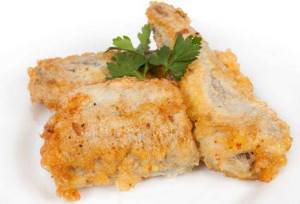
Predator or not
Pelagic fish species are mostly predators. This is confirmed by the above facts about pollock eating other living organisms. Pollock, like all inhabitants of the aquatic world, occupies an important ecological niche in the waters of the world's oceans and individual seas.
As a dietary feature, the possibility of cannibalism can also be noted. It manifests itself when it consumes larvae and fry of its own species (not adults). The fish in question can happily feed on eggs and hatched fry of other fish species. Large fish of other species are not included in the pollock diet.
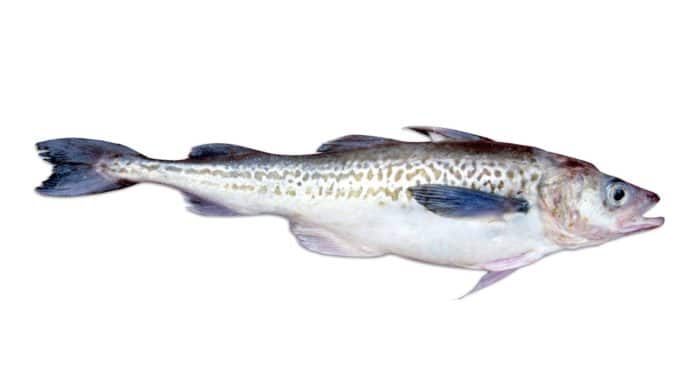
Interesting facts about pollock
Pollock is a long-lived fish. The luckiest fish of this species live up to 20 years - this is the maximum age for which scientists have noted. True, most individuals still do not reach this record, since they are very actively caught. At the same time, as a rule, on the shelves of our stores, pollock is presented mainly as cut carcasses and fillets, so you can see this fish in its natural form only at fishing markets and on advertising brochures (which is much more important for us).
Are there many bones in pollock?
Naturally, pollock has a large ridge along the body and bones extending from the sides. Small bones are not found in other parts of the carcass. Therefore, the fish is not bony.
The side bones are easily pulled out for later eating of the fish. But provided that the fish is of good quality, that is, it is not small-sized young fish and not frozen during storage.
When purchasing cut fillets rather than whole headless carcasses, during verification they may also contain a small number of individual bones. This aspect depends on the specific manufacturer. That is, on the specifics of the supplies of fish products purchased by him and the method of production of the semi-finished product. According to organoleptic indicators, this is a disadvantage for pollock.
Diet
Pollock, as already mentioned, is a pelagic fish that lives mainly in the upper water column of the open ocean, in which it obtains food. Pollock spends the main part of its life away from the shore, to which it approaches only for the purpose of continuing its species - for spawning. The same way of life is characteristic not only of representatives of the cod family. Mackerel and tuna are considered pelagic fish.
Pollock at a young age feeds mainly on plankton, namely crustaceans. A growing fish stops being saturated with small prey and begins to be interested in larger ones. Adult pollock feeds on squid and small fish such as smelt or capelin. Sometimes pollock tends to be cannibalistic: it can eat its own larvae, as well as fry.
Where does it live in Russia?
Trademarks produce their products in different regions of the country: Kamchatka, Murmansk region, Yuzhno-Sakhalinsk, Moscow and Moscow region, Ryazan, Kaluga regions, etc. But this does not mean that pollock is found everywhere. Supplies are made from a limited number of locations. Domestic pollock or pollock caught in China ends up on store shelves (we remind you that this country borders Russia, which is why supplies from here are financially profitable). But Chinese manufacturers can artificially increase the water composition of the carcass, thus increasing the mass of the frozen product. Therefore, domestic catch remains prerogative.
Pollock where it lives and lives near the Russian Federation:
- Barencevo sea;
- Bering Sea;
- Japanese Sea.
Aquaculture (when fish is sold through artificial cultivation) is not relevant for pollock. This activity is more justified for salmon and more expensive varieties of fish. Pollock (unlike even salmon, and even more so eel, sturgeon, etc.) is a cheaper fish that is easier to catch on a large scale in the natural environment.
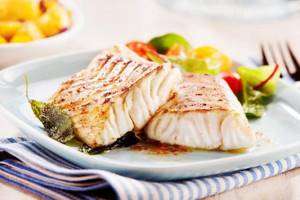
Distribution and habitats
Pollock is a fish that will live in the cold waters of the Pacific Ocean: mainly in its northern part. Like whiting, which lives in the waters of the Atlantic Ocean, pollock is a resource of great nutritional value along with tuna, cod, mackerel and horse mackerel. Near the American coast, the fish is found in Monterey Bay, Alaska, as well as in the waters of the Bering Sea. Off the Asian coast, pollock is found in the Bering, Okhotsk and Japan seas. Pollock populations in the ocean are widespread up to the Sangar Strait, but to the south they are almost impossible to find.
A closely related species of fish, called Atlantic pollock, lives in the waters of the Barents Sea. The fish lives in cold waters, the temperature of which ranges from +2 to +9 degrees Celsius. The preferred depth is no more than 300 meters. Sometimes fish make vertical migrations to depths of up to 700 meters, and sometimes deeper.
River or sea
Important information for determining whether a fish is bony or not is the place in which it lives. That is, whether the fish is sea or freshwater river. Pollock is not characterized as a river variety and belongs to the first type. This means it has fewer bones (especially small ones in the pulp itself). But to be extremely precise, the habitat of pollock is most likely in oceanic waters. Therefore, pollock is categorized as either Pacific or Atlantic. Since the seas flow into the oceans, schools of pollock eventually spread by geolocation and constantly live in the sea area. The main parameters of the waters in which this fish lives are salinity and temperature. Pollock is found where it does not exceed 10 degrees, and the habitat is not freshwater.
Harmful properties of pollock
Eating pollock can lead to the development of allergic reactions. Therefore, if you have an individual intolerance to fish or seafood, then pollock should be completely excluded from your diet. It should not be used frequently by those who suffer from kidney disease, arterial hypertension or peptic ulcers of the stomach and duodenum. This is due to the high content of sodium chloride (table salt) in pollock, which can provoke an exacerbation of the disease.
Video from YouTube on the topic of the article:
Why is it sold without a head?
An important aspect for answering the question posed here is the frequent detection of helminths in the head area of fish. And also the overall usefulness of the product is questioned when selling a full carcass along with the head.
Pollock can indeed have worm-like parasites in its body. The favorite place for parasites is the space behind the gills, but many species of other fish suffer from this problem, not just pollock.
The main point is still the overall value of the whole fish carcass. Previously, in the Soviet Union, pollock fish was not considered valuable or edible. It was mined on a large scale, but for the production of animal feed. That is, it went towards the development of agriculture and ensured the production of food for pets (to a lesser extent). Because of this, its population began to decline sharply, and pollock was transferred to the category of valuable species. At the same time, it entered the diet of residents of the fraternal Soviet countries. Its production has decreased. But it can be said affirmatively that it makes up the majority of the world's fisheries. Its production is very simple (since pollock fish lives in the upper layers of water) and inexpensive. Therefore, the value of the carcass completely disappears. Usually, buyers' heads and entrails go to waste anyway. And for the production of feed, all this is still valuable. Therefore, they are used for production purposes, and carcasses without heads and without tripe enter the consumer market.
The assumption that the fish has an unsightly head and this may aesthetically discourage the buyer from purchasing it is not entirely tenable. You can verify this by looking at a photo of pollock.

The benefits and harms of pollock
Useful properties of pollock
Containing a significant amount of substances useful to humans, pollock is almost the most accessible fish for the general population. Pollock is very simple to prepare, does not require any special frills, and at the same time perfectly regulates metabolic processes in the human body. In particular, this fish has pronounced antioxidant properties, and is also vital for diabetics (as a blood sugar regulator).
The combination of iodine and chromium in one product is an excellent opportunity to regulate the condition of patients with diabetes. Pollock should be a regular dish in the diet of such patients, since chromium regulates lipid and carbohydrate metabolism, thereby normalizing blood sugar levels. In addition, being a stimulator of the production of certain enzymes, chromium can affect heredity.
As for the amount of iodine in a pollock carcass, there is enough of it so that, with regular consumption, you will forever forget about the deficiency of this microelement in the body (as well as about problems with the thyroid gland). Because to satisfy a person’s daily need for iodine, only 100 grams of pollock are required.
Let us also note that iodine is useful not only for the thyroid gland. By normalizing the production of thyroxine (hormone), this microelement regulates the functioning of the cardiovascular system, liver and central nervous system. Moreover, thyroxine serves as a regulator of a person’s emotional state! Therefore, with a lack of iodine, it is possible to develop a depressive state during the recovery period of a person after certain types of diseases.
In addition, pollock has a positive effect on the condition of the mucous membranes of the digestive system and has a beneficial effect on the balance of the nervous system. Being a fish of the northern seas, pollock contains vitamins that allow the human body to quickly recover from illnesses and injuries. Pollock proteins are easily digestible, and the presence of polyunsaturated fatty acids (even in small quantities) improves the functioning of the gastrointestinal tract and liver.
The presence of cobalt in pollock (100 grams - 150% of the daily requirement) once again confirms the usefulness of this unique fish. Because cobalt regulates carbon metabolic processes in the human body, promotes the absorption of iron (thereby reducing the risk of anemia), and is also an important part of the blood clotting mechanism.
Potassium makes pollock an excellent “removal” of excess fluid from the body. Fluoride strengthens bone tissue. Therefore, pollock is very useful for older people with “light” bones and frequent fractures. On top of that, pollock should be included in the diet of young children at least once a week for natural caries prevention.
And finally, the combination of phosphorus and potassium increases the efficiency of brain activity and has a beneficial effect on the acid-base balance.
Potential harm to pollock
Pollock can cause harm to humans only in two cases:
- if a person has an individual intolerance to seafood and any fish
- pollock will be caught in the chemically polluted waters of the world's oceans (which may well happen, given the recent events in Japan, not far from where it is most often caught)
Is it possible to eat the head
Parasitic worms are found inside various representatives of the animal world and humans (ascaris and pinworms are common in the human population). Therefore, their presence in fish is not something shocking. The life cycle of such worms involves the transition from one host to another in the form of eggs, larvae or adults. They can enter the body when they are present in unprocessed food. Therefore, consuming raw fish is dangerous to health. After all, worms can settle not only inside the head. During heat treatment, the danger to humans is reduced to zero. But this is an additional point for refusing to sell carcasses together with the head. Fundamentally, this by-product has no nutritional value for consumers themselves, because the fish is cheap.
Where is pollock found?
The “little brother of cod” lives in the North Pacific Ocean. Its main diet consists of bottom plankton, young squid and small crustaceans. The length of the carcass reaches a maximum of half a meter, and the weight usually ranges from 300 grams to half a kilogram. But there were also quite large individuals. It happened that the catch included a huge pollock weighing about 4 kg.
The production of this fish is carried out mainly by northern states: Russia, Finland, Norway and others. Pollock is caught in the Sea of Okhotsk, Bering, Japan and Barents. The demand for it is so high that some time ago Greenpeace activists asked to reduce the regular catch. Nevertheless, the population manages to recover; the fish is still very common in stores and fish markets.
Pollock is used unusually widely in nutrition, and the list of its beneficial properties and healing abilities for the body sometimes exceeds many valuable varieties of noble fish. Due to its cheapness and prevalence, pollock is fed to domestic animals. Owners especially often offer it to their cats and dogs. Fluffy pets like pollock, its tender white meat.
Chemical composition and KBZHU
Pollock contains:
- valuable acids: polyunsaturated (arachidonic, omega-3, linoleic), saturated (stearic, myristic, palmitic), monounsaturated (oleic, palmitoleic);
- vitamins: A, C, Retinol, PP, B1 and B2, as well as B6 and B9;
- microelements: calcium, phosphorus, magnesium, sodium, potassium, etc.;
- trace elements: zinc, iron, iodine, fluorine, etc.
Pollock is a leader in the level of beneficial selenium, iodine, and protein. It also has low histamine levels, which is a positive feature.
Nutritional value per 100 g:
- fats - 0.9 grams;
- proteins - 15.9 grams;
- cholesterol - 50 milligrams;
This fish has no calories. There are approximately 70 kcal per 100 grams of product. Thanks to this, pollock can be considered dietary. But when frying, the calorie content increases due to the oil used.
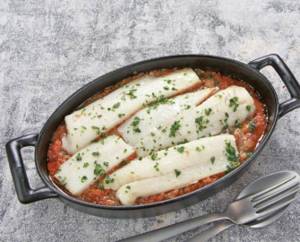
Origin of the species and description
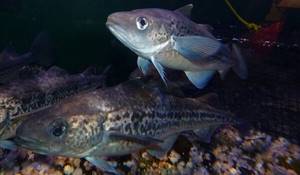
Photo: Pollock
Pollock can confidently be called a cold-loving fish, belonging to the order Codidae, the cod family and the genus Pollock. Pollock is widely known all over the world because it has excellent taste, dietary and very healthy meat, which has few bones.
Interesting fact: Pollock is used to produce the long-loved crab sticks, fish snacks for beer, the famous Filet-o-Fish hamburger at McDonald's, etc.
The commercial importance of pollock is enormous. Among all its cod relatives, pollock is the leader in terms of catch volumes. It is believed that approximately half of the global pollock catch per year comes from England and European countries, the rest of the catch is carried out by fishing companies in our country. Pollock has different varieties, the most famous of which are Atlantic and European pollock.
Video: Pollock
In stores we are used to seeing pollock frozen, small in size and without a head. In fact, this fish can grow up to one meter in length and weigh about 3 kg, although the average size of pollock is 75 cm, and it weighs about one and a half kilograms. In our country, the minimum commercial size is considered to be pollock, the length of which is 20 cm. Some sources claim that the fish can grow up to five kilograms. Perhaps there are such weighty specimens in the vastness of the World Ocean, because the water depths hide many secrets and mysteries.
Selection and storage
Pollock is often supplied to stores frozen. When choosing it, you need to pay attention to certain parameters. First, what the fish looks like. The surface of the carcass should have a light and uniform shade. The presence of stripes and extra inclusions of yellow or green color (not spots of natural origin in the color of the fish) indicates that the carcass was thawed and frozen again. The presence of snow and ice indicates improper storage with a possible loss of the taste of the fish during its preparation. According to GOST, frozen specimens must be stored at a temperature not lower than -18 degrees. This is the only way the fish retains its taste and beneficial properties.
When choosing by manufacturers, keep in mind that the Far Eastern ones are more often than others characterized by the high quality of their product. Russian manufacturers sell a cheaper product, so it is popular as an export.
“After purchasing fish and for its further preparation, you need to defrost it correctly. It is better to do this in a gentle mode, that is, move the carcasses from the freezer to the main cooling chamber. Otherwise, the fish dish becomes tasteless.”
Reproduction
Young pollock reaches sexual maturity at 3 or 4 years of age. By this time, he is already gaining his maximum mass, which is unlikely to change. It usually ranges from 2.5 to 5 kilograms, depending on the habitat of the fish. Since pollock lives for about 16 years, one individual spawns approximately 11–12 times. Pollock swims to the shores in very dense schools, mainly in shallow water, where the depth is only 50–100 meters.
Pollock spawns at different times of the year. Any coast of the Pacific Ocean becomes spawning grounds. In the Bering Sea, the spawning period occurs in spring and summer: spawning occurs from March to early September. In the southern parts of the Pacific Ocean, pollock spawns exclusively in winter and spring. In this case, spawning begins at the end of November, and the spawning period ends in March. In Kamchatka, spawning occurs only in spring.
The eggs released from the body are suspended in the water column. It usually swims at a depth of about 50 meters. A distinctive feature is that pollock can reproduce at subzero temperatures of –2…–1 degrees Celsius. This is possible due to the fact that salt water freezes under more severe temperature conditions, and pollock does not freeze due to the natural antifreeze contained in the blood.
Fish is caught on an industrial scale using fixed nets and trawls. Its meat is valued for its low fat content, high taste, low bone content and high protein content. The photo above shows a photo of a pollock dish: it looks delicious!
Properties
General useful qualities:
- strengthening the immune system thanks to the beneficial substances and vitamins contained here;
- maintaining the functioning of all vital systems of the body (increased zinc and iodine content ensures the normal functioning of the reproductive system and other properties);
- strengthening teeth and bones;
- reducing blood cholesterol and reducing the risk of developing atherosclerosis (when switching to proper nutrition including pollock);
- also increasing the elasticity of vascular walls;
- improving skin quality;
- etc.
Fish contains many useful substances, which is why its consumption is recommended for children and adults.
Negative properties are extremely difficult to identify. For example, an allergy to seafood is acceptable. But pollock in this regard can be called a non-allergenic product.
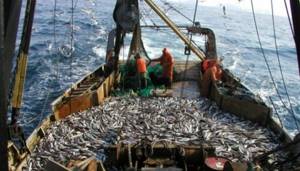
Why pollock is useful
Pollock is found in the Pacific and Atlantic oceans and feeds on plankton, squid and small crustaceans. In very rare cases, fish grow more than 45 centimeters; the weight of an adult individual, on average, ranges from 250 to 500 grams.
The benefits or harms of pollock are due to its rich composition, which contains vitamins, minerals, and fatty acids. By eating this fish, you can quickly tidy up dull hair and brittle nails, and eliminate flaking skin.
Pollock caviar and liver serve as raw materials for the production of cosmetics intended for the care of mature skin. The components that make up these derivative products, antioxidants, also affect the formation of collagen fibers. Extract from gonads is used in the production of cosmetics with regenerating properties.
Pollock is used for medicinal purposes. Eating fish has a positive effect on vision and eye health, and on the functioning of the heart muscle. It also has a beneficial effect on the genitourinary, endocrine (thyroid) and digestive systems.
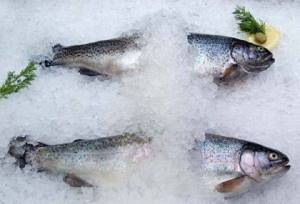
For people who want to lose weight, pollock is an indispensable product: low in calories, rich in nutrients, tasty and filling at the same time.
Tip: Pollock does not burn fat. Body weight loss occurs due to the low calorie content of the product. To ensure efficiency and normal functioning, the subcutaneous layer of fat disintegrates. Little energy is spent on digesting and processing fish.
Important! The beneficial properties for the body will be fully revealed if pollock dishes are present in the diet at least 2 times a week.
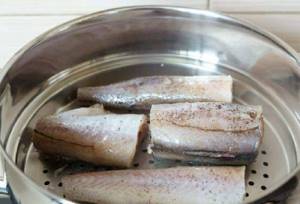
Pollock is an ideal solution for acne or problem skin. Almost all teenagers face this unpleasant phenomenon. Pollock contains very little fat and therefore does not provoke increased activity of the sebaceous glands, while the fish contains a lot of zinc, which prevents the appearance of acne.
The negative effect on the body may be due to the individual characteristics of the person and the amount of fish present in the diet.
A large amount of sea salt, which is contained in pollock, increases blood pressure and, if consumed too often, damages the mucous membranes.
Consumption of pollock is contraindicated:
- In case of allergy to seafood.
- Individual intolerance to products containing sea fish.
- Existing hypertension.
Fishing
If we take cod species into account, pollock occupies a leading place among them in terms of catch volume. To a greater extent, this volume also depends on the place of production, the fertility of the pollock generation and seasonality.
It should be noted that in the 90s. its production was estimated at about five million tons per year. Since this caused the threat of extinction of the species, many countries reduced its production several times.
For Russia, the production of this species in volume is almost half of the total fishing volume.
Pollock: description, preparation, composition, benefits and harm
Pollock (lat. Theragra chalcogramma) is a very common fish belonging to the Cod family. The largest populations of pollock are found in the North Pacific Ocean. Pollock, together with blue whiting, was not considered a serious food resource just a few decades ago. However, with the depletion of stocks of other fish species, the volume of catch of these two named species is increasing every year, amounting to about 3,200 thousand tons on a global scale in 2015, and the Russian catch in the same year amounted to 1,652 thousand tons. As you can see, half of the world's pollock production is caught by Russian fishermen. The leading places in pollock production are also occupied by Germany, France and the UK.
Pollock now ranks first in the world in terms of production among all other fish. Pollock is caught mainly by trawls and fixed seines. The size of the catch is highly dependent on the size of the pollock population in the ocean, which can vary quite widely from year to year, as well as from the fishing season. Currently, pollock stocks have begun to decline sharply due to overfishing, which has led to calls from Greenpeace since 2009 to refrain from purchasing and consuming this fish and its products.
A close relative of this fish is the Atlantic pollock (lat. Theragra finnmarchica) discovered in the Barents Sea, which, due to limited stocks, is of no commercial value.
Description of pollock
Pollock is a medium-sized fish. The maximum length reaches 90 cm with a weight of almost 4 kg.
Pollock lives up to 15 years.
There are three fins on the back. Characteristic features of the fish are also the presence of a very short barbel on the chin, the location of the pelvic fins in front of the pectoral fins, spotted coloring and large eyes.
Pollock lifestyle
Pollock lives in cold waters (with a temperature of 2-9 o C), preferring to stay at depths of 200-300 m (pelagic fish). It often makes vertical migrations, descending to depths of 500-700 m and even deeper.
Puberty occurs at 3-4 years. By this age, the fish reaches its maximum weight and hardly grows any further.
During the spawning period, it approaches the shores and stays at depths of 50-100 m, forming very dense aggregations. Spawning can take place at different times of the year: in the Bering Sea from March to October, off the coast of the Korean Peninsula from November to March, off the coast of Kamchatka in the spring. The water temperature affects this; females can spawn even at a sea water temperature of -1.8 o C. The eggs are pelagic.
The diet of young pollock includes small crustaceans (plankton), then, as they grow older, pollock switches to feeding on small fish (capelin, smelt) and squid. Cannibalism (eating one's own larvae and fry) is a very common phenomenon among pollock.
Pollock in cooking
If you are not a resident of the Pacific Coast or even just the Far East, you are unlikely to be able to buy fresh pollock in the store. It is usually sold frozen, either whole or as fillets.
Among pollock products in retail chains you can also find salted caviar and pollock liver. The main filler of the so-called “crab sticks” and “crab meat” is pollock (fillet). Surimi is from the same series.
Beer lovers should be well aware of the now widely sold “amber fish with pepper.” This is dried pollock.
Countless dishes can be prepared from pollock. The fish meat is dry and dietary, which should be taken into account when preparing pollock. So, if you decide to bake it, it is best to do it with vegetables (tomatoes, peppers, carrots, onions) and in foil, otherwise it will turn out dry. If you decide to fry fish, then after shallow frying it is advisable to close the pan with a lid and simmer the fish in this way.
Pollock soup will be very healthy and tasty, in which, for variety, you can put several pieces of fattier fish (halibut, salmon, etc.).

Pollock is a very popular fish, the taste of which is known to many citizens since childhood. Back in Soviet times, there were so-called fish days, when workers and employees in canteens were offered pollock on Tuesdays and Thursdays. The size of the pollock population is simply huge, so the fish is widespread throughout the world, including in North America. The famous McDonald's uses fillets of this fish to prepare breaded fish sticks, as well as to prepare a host of other fish dishes.
Pollock how to select and store
Fresh pollock is stored for a maximum of a couple of days, then it must be cooked or, in extreme cases, frozen. In the freezer, subject to all conditions and a temperature not exceeding minus 18 degrees, it can be stored for 10 months.
Repeated freezing of a product negatively affects both its taste and overall benefits to the body. Fish simply becomes useless no matter how you cook it. You can distinguish such an individual from one that was once frozen by the following characteristics:
The body is smooth, without bulges or holes;
no damage to the skin;
The fins do not stick out, but fit neatly and tightly to the abdomen and back;
The ice is white or transparent, without bloody stains;
A thin layer of ice on pollock indicates compliance with the rules of freezing and storage;
The carcasses are not glued together;
The fish meat is white, but not yellow or gray.

